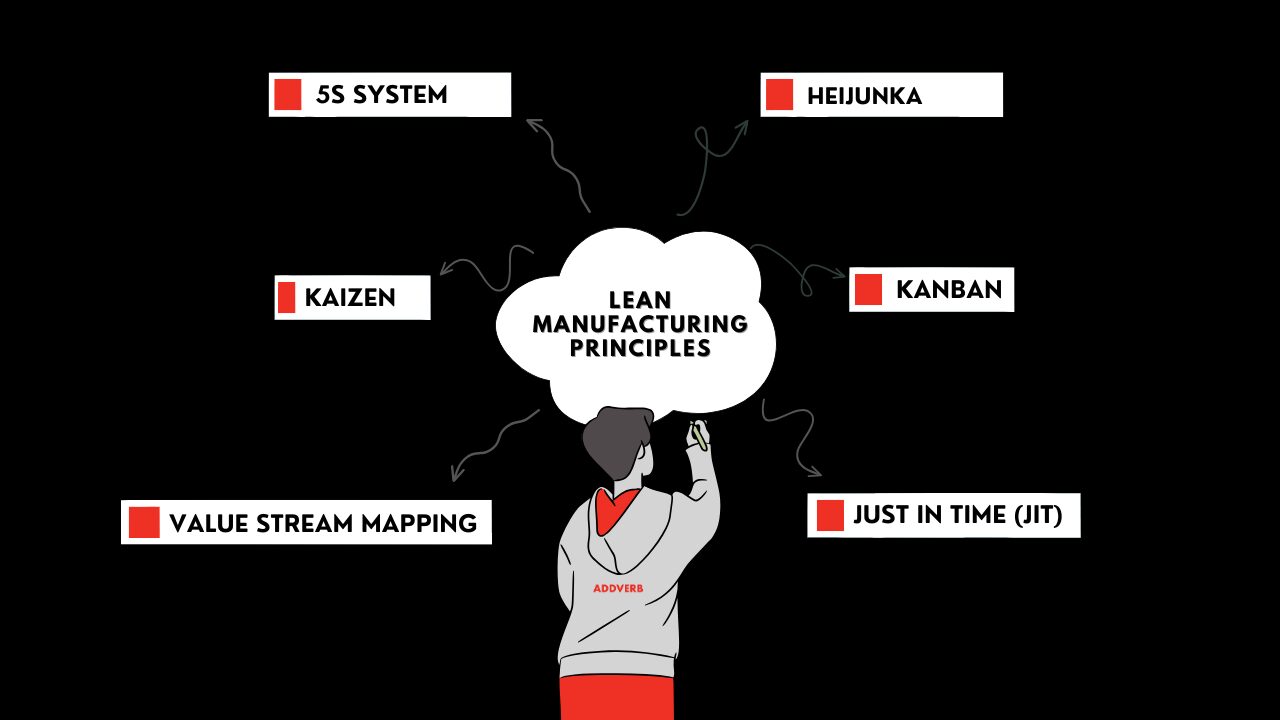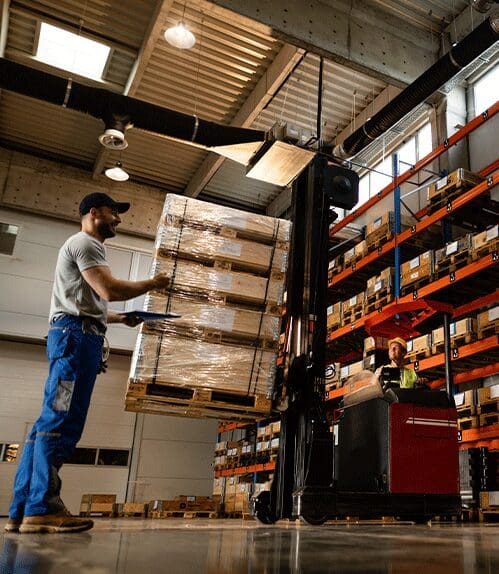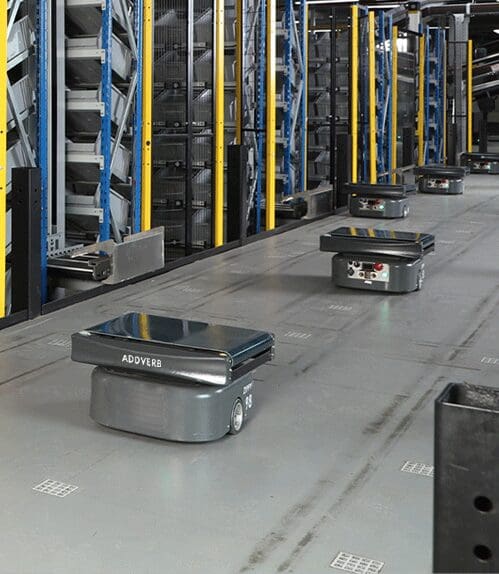Table of Contents
A well-organised lean warehouse can considerably reduce inventory costs with the use of the right automation. Lean manufacturing solutions have the power to enhance manufacturing processes and increase productivity. By increasing efficiency, eliminating errors, and improving customer satisfaction, it can further ensure that the right product is delivered to the right consumer at the right time.
Furthermore, lean warehouse management offers better visibility of warehouse operations, enabling prompt decision-making.
What is Lean Warehousing?
Lean warehousing constitutes a warehouse management system that prioritises efficiency and waste reduction. It follows lean manufacturing principles by cutting waste, reducing inventory, and improving efficiency. It often includes technologies like automated storage and retrieval systems (AS/RS), warehouse control systems (WCS), and warehouse management systems (WMS)
The core principles of lean Warehousing
- Reducing waste in warehouse processes
- Cutting unnecessary inventory
- Enhancing operational efficiency
- Ensuring accurate and high-quality data
- Elevating customer satisfaction
Redefining Efficiency: The Importance of Lean Warehousing
Warehouse management is vital because it ensures products and materials flow smoothly in and out of a warehouse. It covers processes like receiving, storing, retrieving, and distributing goods efficiently. Effective warehouse management also helps organisations keep the right amount of inventory to operate smoothly.
Addverb implements solution with Lean process to make best, scalable solutions for Clients and Partners, Contact us to know more.
Advantages of lean Warehousing
- Enhanced Efficiency: It focuses on waste reduction and process enhancement. This, in turn, decreases costs and boosts customer service quality.
- Heightened Productivity: It improves productivity by streamlining processes and cutting down the time it takes to move goods from one point to another.
- Inventory Reduction: It maintains lower inventory levels by ensuring only essential items are stocked, eliminating the need for excessive storage.
- Improved Quality: It reduces defects and elevates quality by closely monitoring and tracking processes.
- Greater Agility: It adds flexibility to the supply chain and facilitates quicker response times as well as more efficient inventory management.
- Enhanced Safety: It reduces safety risks by minimising unnecessary material handling and improving process safety.
- Waste Elimination: It attains waste reduction by decreasing the number of stocked SKUs, using automated technology for efficient inventory tracking, and employing barcoding and RFID tech to cut down on manual data entry.
Defining Lean Manufacturing
Lean manufacturing is a production system with a core focus on waste elimination, efficiency enhancement, and cost reduction. It draws its principles from the Toyota Production System, often referred to as the “Just in Time” production approach.
Key aspects of lean manufacturing include a commitment to
- Continuous Improvement: Consistently enhancing processes and methods to drive efficiency and quality.
- Inventory Reduction: Keeping inventories at minimal levels to save on storage costs and improve responsiveness.
- Quality Improvement: Striving for higher product and process quality standards.
- Cultivating a Culture of Continuous Improvement: Instilling a mindset of ongoing enhancement throughout the organisation.
Additionally, lean manufacturing is about identifying and eliminating sources of waste, including issues like overproduction and unnecessary movements, which can impede efficiency and drive up costs.
How Are Lean Manufacturing and Lean Warehousing Connected?
Lean manufacturing and lean warehousing share a common objective of streamlining processes and waste reduction, but they employ distinct lean principles to achieve this:

In Lean Manufacturing, these principles include
- 5S System: Organising the workspace for efficiency and cleanliness
- Kaizen: Continuous improvement to enhance processes incrementally
- Value Stream Mapping: Analysing and optimising the flow of materials and information
In Lean Warehousing, the focus shifts to reducing costs and enhancing efficiency using principles such as:
- Just in Time (JIT): Minimising inventory levels and replenishing stock precisely when needed
- Kanban: Employing visual cues to manage inventory and production
- Heijunka: Leveling production to maintain a consistent workflow
How to Achieve a Better Outcome with Lean Warehousing
To attain favourable results in lean warehousing, it is crucial to implement the right practices. Let’s explore some key practices:
Utilise Lean Techniques: Lean tools like 5S, Kaizen, and Value Stream Mapping can identify and eliminate warehouse waste, helping detect inefficiencies and enhance processes.
Implement Automation: Automation simplifies operations and reduces manual labour requirements. Automated systems can accelerate tasks like order picking, packing, and shipping. Find out more about these warehouse automation products here.
Invest in Technology: Technology, such as warehouse management systems and automated picking solutions, can streamline operations and boost efficiency.
Optimise Space Usage: Maximising warehouse space minimises costs and boosts efficiency. Utilise vertical and aisle space efficiently and implement lean storage solutions.
Reevaluate Inventory: Regular inventory reviews and adopting a Just-In-Time system can reduce storage costs.
Track Performance: Continuous improvement is crucial. Monitor performance metrics like lead times and throughput to identify areas for improvement.
Streamline Order Fulfilment: Simplifying order fulfilment by reducing steps, automating tasks, and optimising layout can cut costs and improve customer satisfaction.
Implement Cross-Docking: This practice involves transferring goods directly from incoming deliveries to outgoing shipments, eliminating the need for warehousing and improving efficiency.
Utilise Barcoding: Barcoding efficiently tracks inventory, improving accuracy, movement speed, and reducing labour costs while enhancing visibility in the supply chain.

Ways to Identify Opportunities to Implement Lean Automation
Approximately 69.7% of manufacturers use various lean practices. Some of these lean methods are more challenging to implement than others, but all of them demand at least a moderate level of effort. Nevertheless, it’s crucial not to ignore the significant advantages they can bring in a competitive landscape.
However, investing in lean automation may entail expenses, it’s important to note that it is not a universal solution. Consequently, it is crucial to pinpoint the specific areas within your warehouse that will reap the most benefits.
You can achieve this through the PDCA model, which consists of four distinct steps: Plan, Do, Check, and Act. This model offers a straightforward and efficient method for problem-solving and change management.
Let’s delve into how you can leverage this model to identify opportunities for implementing lean automation:
Step One: Planning
To begin, take the time to identify areas within your warehouse that require improvement and determine the most suitable solutions to address these issues.
For instance, if your warehouse encounters challenges related to picking errors, consider investing in software solutions like a stock management system.
Once you have formulated a plan, it’s time to initiate the next phase: taking action.
Step Two: Do
Now that you have pinpointed the warehouse areas suitable for lean automation, it’s time to put your chosen solutions into action. Keep in mind that challenges may emerge during this phase, so consider starting with a limited-scale implementation in a controlled setting.
For instance, you can begin by implementing a stock management system in one specific section of your warehouse. As an example, you might decide to test the solution in your picking area once or twice a week to gauge its effectiveness.
Step Three: Check
This step is crucial and must not be overlooked. In the evaluation stage, you will need to assess the implementation of your plan to determine its effectiveness.
If you observe a significant reduction in picking errors, it’s evident that the solution is effective and may warrant further investment on a larger scale. However, if picking errors persist at the same level, it may indicate that the type of automation you introduced may not be the right fit for your needs.
Collaboration with your team is vital during this phase. Request feedback to identify any issues and ascertain whether the automated solution has enhanced operations.
Step Four: Act
In the last phase, decide on whether to invest in the automated solution or explore alternative options. If you opt for a different approach, repeat the process. This repetitive method enables your team to identify, test, and enhance solutions, creating an ongoing cycle focused on waste reduction.
Why Automation is Beneficial for Lean Manufacturing?
Manufacturing automation and lean manufacturing share a common objective: satisfying customers while minimising costs through focusing on eliminating low-value or non-value activities, cutting waste, and ensuring consistent quality. However, blending these two can be challenging for even experienced manufacturing experts. Let’s explore several advantages that harness the synergies between automation and lean manufacturing.
Reducing waste
Automation is a great way to cut waste. Well-set-up machines make parts accurately and can warn if things go off track, preventing mistakes and the need for rework – both critical issues in lean manufacturing. Automation is especially efficient for routine tasks where even skilled operators cannot match their precision. Plus, it reduces wasted effort in two ways:
- Many automated machines can do multiple tasks, so there is no need to move materials around.
- When a task is done, automated machines can move materials to the warehouse or the next step without needing people to step in.
Internet of Things (IoT)
Linking equipment to business systems simplifies reporting production status. IoT eliminates the manual reporting of task completion, scrap, or material usage for accounting and inventory systems. This allows operators to concentrate on more valuable tasks to meet customer demands.
Improving accuracy
Inventory management is vital in manufacturing, yet it can be inefficient. To serve customers effectively, precise inventory control is essential. One way to achieve this is by automating the picking and storing of items. Automation reduces the chances of losing or misplacing materials and ensures accurate tracking, minimising waste from expired or spoiled items.
Enhancing safety
The implementation of warehouse automation can enhance employee safety, as most workers will have fewer reasons to enter the automated storage and retrieval system (AS/RS) zone or walk through the warehouse, except for maintenance purposes. Consequently, the likelihood of falls in an automated warehouse is likely to decrease.
Implement Lean Manufacturing with Addverb
Addverb provides a wide range of automation solutions that can be used in a lean manufacturing environment. Our automation solutions have been crafted to improve productivity and efficiency while decreasing waste across a variety of industries. From material handling to automated inventory management, Addverb can create custom solutions tailored to your application and product. Want to know more about how we can enhance your lean manufacturing and warehouse operations? Get in touch today!
Bottom Line
The fusion of lean manufacturing and automation is a transformative force that can propel your operations to new heights of efficiency, cost-effectiveness, and customer satisfaction. By embracing the principles of waste reduction and continuous improvement, along with the right technological solutions, you can ensure your manufacturing processes are lean, mean, and primed for success.






